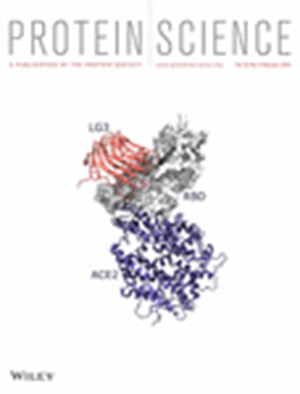通过金属依赖性多态性形成多样化的晶体蛋白质支架
IF 4.5
3区 生物学
Q1 BIOCHEMISTRY & MOLECULAR BIOLOGY
引用次数: 0
摘要
随着蛋白质晶体作为支架的应用越来越多样化,受控晶体多态性提供了一种简便的策略,可以形成具有可控孔隙率的晶体组装体,而且只需极少或无需进行蛋白质工程。通过与金属盐共结晶,利用金属离子固有的几何要求,获得了具有不同孔隙率的共识四肽重复蛋白多晶体。尽管存在大量带负电荷的残基,但只有一个结构上暴露的负氨基酸簇负责金属配位。密度泛函理论计算表明,虽然大多数晶体是热力学上最稳定的组装体,但也有一些是动力学上的受困状态。因此,通过金属配位实现并控制了晶体孔隙率的多样性,为蛋白质作为生物兼容的蛋白质-金属-有机框架(POFs)的应用开辟了新的领域。此外,依赖金属的多晶体还可以直接比较金属配位的偏好。本文章由计算机程序翻译,如有差异,请以英文原文为准。
Diverse crystalline protein scaffolds through metal‐dependent polymorphism
As protein crystals are increasingly finding diverse applications as scaffolds, controlled crystal polymorphism presents a facile strategy to form crystalline assemblies with controllable porosity with minimal to no protein engineering. Polymorphs of consensus tetratricopeptide repeat proteins with varying porosity were obtained through co‐crystallization with metal salts, exploiting the innate metal ion geometric requirements. A single structurally exposed negative amino acid cluster was responsible for metal coordination, despite the abundance of negatively charged residues. Density functional theory calculations showed that while most of the crystals were the most thermodynamically stable assemblies, some were kinetically trapped states. Thus, crystalline porosity diversity is achieved and controlled with metal coordination, opening a new scope in the application of proteins as biocompatible protein‐metal‐organic frameworks (POFs). In addition, metal‐dependent polymorphic crystals allow direct comparison of metal coordination preferences.
求助全文
通过发布文献求助,成功后即可免费获取论文全文。
去求助
来源期刊

Protein Science
生物-生化与分子生物学
CiteScore
12.40
自引率
1.20%
发文量
246
审稿时长
1 months
期刊介绍:
Protein Science, the flagship journal of The Protein Society, is a publication that focuses on advancing fundamental knowledge in the field of protein molecules. The journal welcomes original reports and review articles that contribute to our understanding of protein function, structure, folding, design, and evolution.
Additionally, Protein Science encourages papers that explore the applications of protein science in various areas such as therapeutics, protein-based biomaterials, bionanotechnology, synthetic biology, and bioelectronics.
The journal accepts manuscript submissions in any suitable format for review, with the requirement of converting the manuscript to journal-style format only upon acceptance for publication.
Protein Science is indexed and abstracted in numerous databases, including the Agricultural & Environmental Science Database (ProQuest), Biological Science Database (ProQuest), CAS: Chemical Abstracts Service (ACS), Embase (Elsevier), Health & Medical Collection (ProQuest), Health Research Premium Collection (ProQuest), Materials Science & Engineering Database (ProQuest), MEDLINE/PubMed (NLM), Natural Science Collection (ProQuest), and SciTech Premium Collection (ProQuest).
 求助内容:
求助内容: 应助结果提醒方式:
应助结果提醒方式:


